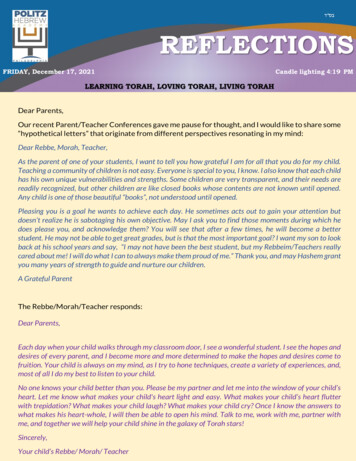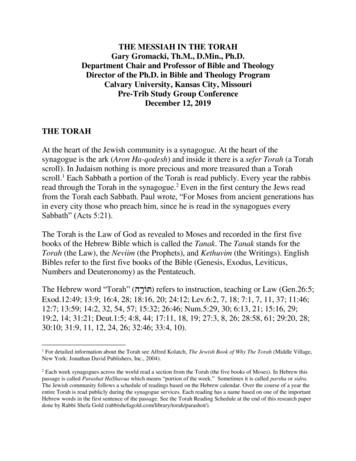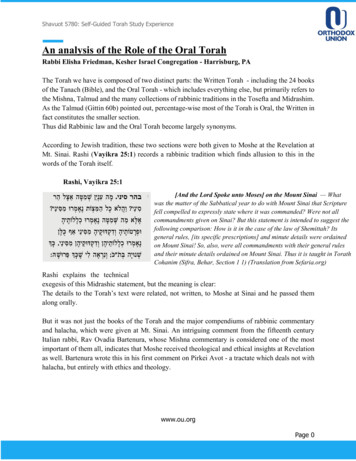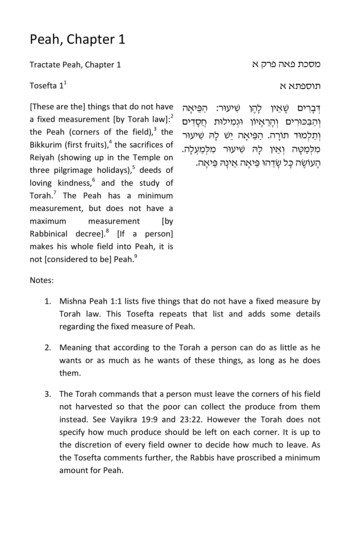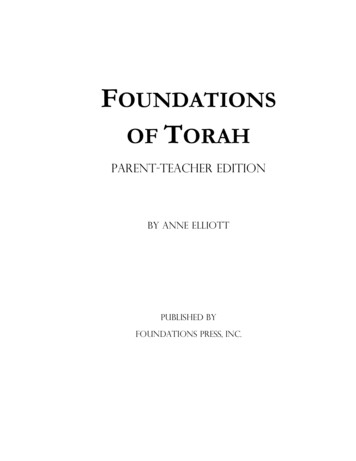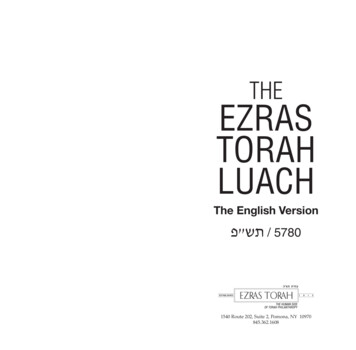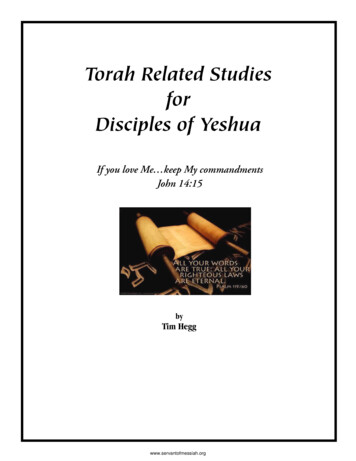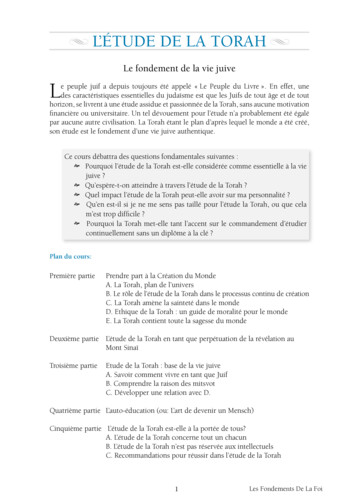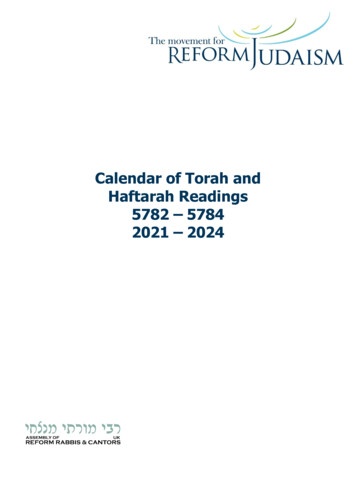
Transcription
FRAADE F10 174-197.indd 1747/17/2006 6:27:20 PM
ORAL TORAH VS. WRITTEN TORAH(S):COMPETING CLAIMS TO AUTHORITY*CANA WERMANBen-Gurion UniversityThe Claim to Authority and the Qumran CommunityThe halakhic writings originating in the Qumran community show theearly fusion of many commandments of the Torah into a consolidatedlegal system1 that in turn is indicative of attention and fidelity to theTorah and its worldview.2 Once we penetrate the sectarian outergarb of these writings, we uncover details and general principles thatare not characteristic of a dissident community. Consequently, these* This research is supported by the Israel Science Foundation (grant n. 733/03).1A. Schremer (“‘[T]he[y] Did Not Read in the Sealed Book’: Qumran HalakhicRevolution and the Emergence of Torah Study in Second Temple Judaism,” in HistoricalPerspectives: From the Hasmoneans to Bar-Kokhba in Light of the Dead Sea Scrolls. Proceedingsof the Fourth International Symposium of the Orion Center for the Study of the Dead Sea Scrollsand Associated Literature, 27–31 January 1999 [ed. D. Goodblatt et al.; STDJ 37; Leiden:Brill, 2001], 105–26), argues that the members of the Qumran community were thefirst to engage in the exegetical study of the Torah, because of a halakhic controversythat arose in their time. Schremer implies that Torah study began in 150 BCE. Thevery existence of a halakhic disagreement, however, speaks of the prior developmentof the halakhah, leading us to assume an established practice of Torah study beforethe withdrawal of the Qumran community. Prolonged Torah study among the eliteand at the center of the nation’s religious life may explain the existence of interpretivetraditions that were common to different groups and that appear in various writingsover the course of centuries. For descriptions of these shared traditions, see: J. L. Kugel,Traditions of the Bible (Cambridge, MA: Harvard University Press, 1998); M. Kister, “ACommon Heritage: Biblical Interpretation at Qumran and Its Implications,” in BiblicalPerspectives: Early Use and Interpretation of the Bible in Light of the Dead Sea Scrolls. Proceedingsof the First International Symposium of the Orion Center for the Study of the Dead Sea Scrolls andAssociated Literature, 12–14 May 1996 (ed. M. E. Stone and E. G. Chazon; STDJ 28;Leiden: Brill, 1998), 101–11.2This appears to characterize the concept of “priestly halakhah” which is frequentlyinvoked when discussing halakhah at Qumran; that is, a halakhah whose fundamentalconstitution is the Pentateuch, and whose laws are fashioned in accordance with thisconstitution in a way that attempts to resolve contradictions and to rule betweeninconsistent sources. This halakhah acquired distinctive features when adapted by theQumran community, a sect with an apocalyptic worldview.FRAADE F10 174-197.indd 1757/17/2006 6:27:20 PM
176CANA WERMANhalakhot may have been, not the fruits of study by the members of theQumran congregation in isolation, but rather rulings formulated priorto the secession of the community. These halakhot probably evolved inJerusalem, among the Temple priests who engaged in the study of theTorah (are those the soferim [scribes] mentioned in later sources?)3 duringthe Second Temple period, before the sect came into existence. Priestlyauthority in halakhic matters derived from the standing of the Templeas a religious and political center.4 Furthermore, the very Torah that thepriests developed gave them the central role in its dissemination: “They[Levi’s offspring, the priests] shall teach Your statutes to Jacob, YourTorah to Israel” (Deut 33:10). At Qumran, these laws were committedto writing in a variety of literary genres.5 It has not been determined,however, whether the fruits of priestly study and teaching were writtendown before Qumran,6 and if so, in what literary forms these principlesand halakhot were conveyed, whether as collections of midrashim, or ascollections of laws.73E. E. Urbach (“The Derasha as a Basis of the Halakha and the Problem of theSoferim,” Tarbiz 27 [1958]: 173 [Hebrew]) describes the activity of the soferim (thecomparison of parallels, the application of something explicit in another place,the resolution of conflicting texts, and more). Unlike Urbach, I do not believe that suchactivity should be called “derashah.” I find no evidence of the existence of a group ofauthoritative Sages (predecessors of the rabbis) in the period of the Soferim, leading meto disagree with Urbach, who paints a picture that includes this group. See also below.4See a survey of the ruling classes during the Second Temple period in D. Goodblatt,The Monarchic Principle (Tübingen: Mohr [Siebeck], 1994). As was shown by Goodblatt,there are no echoes in Second Temple literature of any representation of the commonpeople in any form of government.5A. Shemesh and C. Werman, “Halakhah at Qumran, Genre and Authority,” DSD10 (2002): 104–29.6The “Book of Decrees” mentioned in Megillat Ta{anit is discussed below. For theclaim that the Temple Scroll is of sectarian origin, see n. 12.7The halakhic part of Aramaic Levi Document, a pre-Qumranic priestly writing formedas a collection of laws, might give us a clue. However, the solar calendar of 364 days,hinted at in Aramaic Levi, points to an origin in an (pre-Qumranic) oppositional group.Thus, we cannot deduce from Aramaic Levi Document clear conclusions regarding thegenre that was used by the Temple priestly circles. On the halakhah in Aramaic Levi see:C. Werman, “The Flood Story in the Book of Jubilees,” Tarbiz 64 (1995): 183–202(Hebrew); C. Werman, “Qumran and the Book of Noah,” in Pseudepigraphic Perspectives:The Apocrypha and Pseudepigrapha in the Light of the Dead Sea Scrolls: Proceedings of the SecondInternational Symposium of the Orion Center for the Study of the Dead Sea Scrolls and AssociatedLiterature, 12–14 January, 1997. (ed. E. G. Chazon and M. E. Stone; STDJ 31; Leiden:Brill, 1998), 171–81.FRAADE F10 174-197.indd 1767/17/2006 6:27:21 PM
ORAL TORAH VS. WRITTEN TORAH(S)177In the middle of the second century BCE, upon the appointmentof Hasmonean High Priests, their allies the Pharisees gained moreinfluence in Jerusalem; they sought to impose their own halakhic system,which included some ancient traditions that contradicted Scripture.8The established Jerusalem priests had to decide whether to accept thehalakhah promoted by the Pharisees, or to withdraw to a place wherethey could maintain the halakhah to which they owed allegiance. Thepriesthood split: one group, that from this time on would be known asthe “Sadducees”9 (? )בית אבשלום 10 chose to remain and cope with thenew reality. Their decision proved wise, since a generation later, duringthe time of John Hyrcanus, the reins of power once again passed tothe priests ( Josephus, Ant. 13.196). Another group, known to us as the“Qumran community,” elected to leave.11The departure of the latter from Jerusalem was also a withdrawalfrom the locus of halakhic power. From this juncture forward, thedissenters could not exercise general authority to explain, interpret,and expand Scripture, for their connections with the Temple had beensevered. In other words, the members of the new Qumran communitycould no longer claim the authority rooted in the Temple and in the civilauthority that the priests had enjoyed until the decrees promulgated byAntiochus. The Qumran community had to develop a different basis fortheir authority; and indeed, we find two different claims advanced by the8On an ancient tradition preserved by the Pharisees see: M. Kister, “Some Aspectsof Qumranic Halakhah,” in The Madrid Qumran Congress: Proceedings of the InternationalCongress on the Dead Sea Scrolls, Madrid, 18–21 March 1991 (ed. J. Trebolle Barrera andL. Vegas Montaner; STDJ 11; Leiden: Brill 1992), 2:571–88.9As was shown by D. Schwartz (“On Two Aspects of Priestly View of Descent atQumran,” in Archaeology and History in the Dead Sea Scrolls. The New York University Conferencein Memory of Yigael Yadin [ed. L. H. Schiffman; JSPS 8; JSOT/ASOR Monographs 2;Sheffield: JSOT Press, 1999], 159) the name ‘Sadducees’ itself is a sign of opposition tothe Hasmonean family.10Habbakuk Pesher 5:9; M. Stern, Hasmonaean Judaea in the Hellenistic World: Chapters inPolitical History (ed. D. R. Schwartz; Jerusalem: The Zalman Shazar Center for JewishHistory, 1995), 57–58 and n. 26 (Hebrew).11To intensify the rift with the rest of the nation, the Community embraced a 364day calendar. Of Babylonian origin (W. Horowitz, “The 360- and 364-Day Year inAncient Mesopotamia,” JANES 24 [1996]: 35–44), this calendar is presented to Enochby the angel Uriel in 1 Enoch. The author(s) of 1 Enoch also put a statement in Uriel’smouth, declaring that in the future, because of the people’s sins, the celestial bodies willchange their route. This angelic claim is a hidden confession that 364-day calendar cannot be in use in the author’s days. The use of the 364-day calendar by the Communitymembers is a revolutionary act.FRAADE F10 174-197.indd 1777/17/2006 6:27:21 PM
178CANA WERMANmembers of the community in justification of their halakhic approach.One, alluding to the traditional priestly perspective, looked to MountSinai, to argue that the interpretation of the Torah in accordance withpriestly halakhah had already been given to Moses. The other, derivingdirectly from the circumstances of dislocation from the Temple, identifiedthe source of authority with the leader of the community, the agent ofGod, who provided the community’s members with the hermeneuticaltools necessary for the study of the written Torah.The argument that the explanation and further development of theTorah had already been given over to Moses at Sinai, along with theTorah itself, appears in Jubilees and in the Temple Scroll.12 Accordingto Jubilees,13 Moses received, along with the Torah engraved on stonetablets,14 another written Torah; this second Torah, however, Moseshimself copied.15 The purpose of the second Torah, the Torah andthe texudah (predestined history), which contains the expansion andinterpretation of the first Torah, is to stand before the people as awitness when the correct interpretation is forgotten in the future: “[. . .]this Torah and texudah will confront (them), fo[r they will forget all ofmy commandments, everything which I will co]mmand you” ( Jub. 1:9;exegetically following Deut 31:19–21: “Therefore, write down this poemand teach it to the people of Israel; put it in their mouths, in order thatthis poem may be My witness against the people of Israel [. . .] then thispoem shall confront them as a witness”).1612The prevailing scholarly inclination is not to ascribe sectarian authorship to thesetwo compositions, since they seemingly contain no hint of the rift within the Jewishpeople or of a sectarian worldview that distinguishes between the elect group and thesinning multitudes. However, as I demonstrated in my essay, “The Book of Jubilees andthe Qumran Community,” in Meghillot: Studies in the Dead Sea Scrolls 2 (ed. M. Bar-Asherand D. Dimant; Haifa: Haifa University Press; Jerusalem: Bialik Institute, 2004), 37–55(Hebrew), Jubilees does presume the existence of a separatist and elect community.13The first column of the Temple Scroll is not preserved, and therefore we cannotknow just how the claim to authority was presented. The second column of the scrollcontains a rewriting of Exodus 34, describing the Revelation at Sinai. We may concludethat the Revelation served as background for the presentation of the Scroll.14In the words of Jubilees [1:1]: “Come up to me to] the mountain, [that I may giveyou] the [two] stone [tablets]—the Tor[ah and the commandment which I have writtendown to in]stru[ct them”; contrast Exod 24:12: “The Lord said to Moses: Come up toMe on the mountain and wait there, and I will give you the stone tablets with the Torahand commandments which I have written down to instruct them.”15Exegetically based on Exod 34:27: “Write down these words, for in accordancewith these words I make with you a covenant and with Israel.”16C. Werman, “The תורה and the תעודה Engraved on the Tablets,” DSD 9 (2002):75–103.FRAADE F10 174-197.indd 1787/17/2006 6:27:21 PM
ORAL TORAH VS. WRITTEN TORAH(S)179The second claim to authority, which locates the prerogative ofinterpretation in the special status of the community and its leader,is set forth in CD. The author of CD believes that the aggregate ofthe commandments comprises both the “revealed” commandments(i.e., those stated explicitly in the Torah) and the “hidden” ones, theinterpretations and laws that have been disclosed only to the membersof the community.17 The author describes the process by which the latterare revealed in an exposition of a verse from the Song of the Well:“The well which the chieftains dug, which the nobles of the peopleexcavated, with the ruler, with their own staffs” (Num 21:18)—the wellis the Torah, and those who dig it are the penitents of Israel who departfrom the land of Judah [. . .] and the ruler is the Interpreter of the Torah,of whom Isaiah said “and produce a tool for his work” (Isa 54:16). Andthe nobles of the people are those who came to excavate the well, withthe statutes which were ordained by the ruler to walk in them in the entiretime of evil. (CD 6:3–9)18According to this metaphor, the “nobles of the people” are the membersof the community, and the “ruler” is the Interpreter of the Torah. Theauthor explains the role of this exegete by comparing him to a smith,aided by a verse from Isaiah (54:16): “It is I who created the smith tofan the charcoal fire and produce a tool for his work.” God createdthe smith, who in turn produces tools in order to continue to produce.The moral of this parable is that the Interpreter of the Torah was sentby God to produce the tools needed for the exposition of the Torah,i.e., the “statutes” thus promulgated. The Interpreter of the Torahtransmits these statutes to the members of the community to enable theQumranites to continue the interpretation of the Torah and the disclosureof the concealed commandments. The author of CD thereby presentsthe halakhic creative process as a combination of human intellectualactivity and divine inspiration: it is the community’s wise men whoexpound the Torah and uncover the hidden commandments, but thisexegetical activity is feasible only by means of the tools that they weregiven through their Teacher, who was sent to them by God.17A. Shemesh and C. Werman, “Hidden Things and their Revelation,” RevQ 18(1998): 409–27.18Translation as in J. M. Baumgarten and D. R. Schwartz, “The DamascusDocument,” in The Dead Sea Scrolls: Hebrew, Aramaic, and Greek Texts with English Translations,Vol. 2: Damascus Document, War Scroll, and Related Documents (ed. J. H. Charlesworth; ThePrinceton Theological Seminary Dead Sea Scrolls Project; Tübingen: Mohr [Siebeck];Louisville: Westminster John Knox Press, 1995), 22.FRAADE F10 174-197.indd 1797/17/2006 6:27:21 PM
180CANA WERMANThe Sages’ Claim to AuthorityThe necessity for two claims to authority in the Qumran communitywill be discussed below. In this section, I will attempt to show that thesetwo claims to authority inherent in the Qumran writings will likely aidus in discerning the two claims to authority advanced by the Phariseesand the Tannaim, two groups that (contrary to the priests) consideredthemselves as abiding by traditions in addition to the Sinaitic revelationpresented in the Pentateuch.Josephus indicates that the Pharisees developed a ramified system ofhalakhot,19 and that they were interpreters of the laws ( J. W. 1:110–111;Ant. 18:12; J. W. 2:162). He does not explicitly connect these laws with theMosaic code, and it therefore cannot be claimed that the Pharisees werethe interpreters of the written Torah.20 Rather, Josephus’s commentsmatch the picture that emerges from the tannaitic depiction of thehalakhic activity of the Sages. The Sages do not study Torah. Theydetermine a halakhah; they discuss halakhic matters among themselves;they raise questions, which they decide by majority decision.21 Consequently, even though the Tannaim do not claim to be the disciples of thePharisees,22 in their activity they are, in fact, the successors of the latter;both groups developed and formulated collections of laws stemmingfrom traditions that existed independently of the Bible.Like the Qumranites, the Sages were forced to rely upon a claim toauthority unrelated to the Temple. I suggest that as the Sages sought19This enables us to understand the charge leveled in the NT (Matt 23:2) that thePharisees see themselves as sitting on Moses’s seat, that is, occupying the seat of thelegislator.20A fact overlooked by M. S. Jaffee, Torah in the Mouth (Oxford: Oxford UniversityPress, 2001), 53, and many others. A survey of the disputes between Beit Hillel and BeitShamai is included in: M. Fish and H. Shapira, “- המחלוקת המטא : פולמוסי הבתים הלכתית בין בית שמאי לבית הלל ,” Iyunei Mishpat 22 (1999): 461–97 (Hebrew). Most ofthe disputes are not the outcome of different reading of Scriptures and do not includederashot. A critical study of the figure of Hillel, with comments on the small numberof midrashim attributed to him are found in: I. M. Gafni, The Jews of Babylonia in theTalmudic Era: A Social And Cultural History ( Jerusalem: The Zalman Shazar Center forJewish History, 1990), 68–76 (Hebrew); D. Henshke, “Studies in the Method of ‘ שני כתובים המכחישים זה את זה ,’” Proceedings of the Eleventh World Congress of Jewish StudiesC.1 (Jerusalem: The World Union of Jewish Studies, 1994), 39–46 (Hebrew); D. R.Schwartz, “Hillel and Scripture: From Authority to Exegesis,” Hillel and Jesus (ed. J. H.Charlesworth and L. L. Johns; Minneapolis: Fortress, 1997), 335–62.21Cf. Jaffee, Torah, 73–82.22Jaffee, Torah, 55–56.FRAADE F10 174-197.indd 1807/17/2006 6:27:22 PM
ORAL TORAH VS. WRITTEN TORAH(S)181to impart authoritativeness to their collection of laws they voiced twoclaims that resembled those of the Qumran community. Nonetheless,there are two significant differences between these sets of authoritativeclaims. The first is that one of the claims advanced by the Sages precededthe other: the claim that a second Torah was given at Sinai belongs tothe Second Temple period, while the second claim to authority, that ofdivinely-inspired human elaboration of the law (parallel to the Qumranargument for both revealed and hidden laws), dates from a latergeneration, and might possibly be ascribed to R. Akiva. The seconddissimilarity is that in the Sages’ early claim to authority, the secondTorah given at Sinai is oral, not written.Admittedly, no Second Temple period source explicitly links thehalakhic system developed by the Pharisees with the Revelation atSinai. As Jaffee demonstrated, in the Christian tradition the Phariseesare characterized as preserving the traditions of the forefathers,23 andJesus charges them with preferring the tradition of the forefathers to thewords of God Himself. Paul contrasts his way as a Pharisee, of fidelityto the tradition of the forefathers, to his way as a believer in Jesus, afterhaving received a divine revelation (Gal 1:11–16). Consequently, divinerevelation stands in opposition to tradition, a human creation. Josephus,as well, emphasizes Pharisee loyalty to the traditions of the forefathers,not written in the Torah of Moses (Ant. 13.297–298; 17.41). As Fraadeobserves,24 these texts do not claim that the tradition of the forefathersis of Sinaitic origin (nor they do not assert that it is unwritten, only thatit is not written in the Mosaic code; see below).I nevertheless would contend that the Pharisees did set forth theargument of the two Torahs, as it was similarly stated by the Tannaim,25since the claim of two Torahs originating at Sinai, one in writing andthe other oral, is embodied in the early stratum of tannaitic literature, asin this disagreement in Sifra between the Tanna Qamma and R. Akiva:“These are the laws, the statutes, and the instructions [torot]” (Lev 26:46)—this teaches that two Torot were given to Israel, one in writing and the otheroral. R. Akiva said: Did Israel have two Torot? Were not many torot given23Jaffee, Torah, 45–50. I do not accept his assumption, however, that the tradition ofthe forefathers was derived from exegesis of Scriptures.24S. Fraade, “Literary Composition and Oral Performance in Early Midrashim,”Oral Tradition 14 (1999): 41.25A. Yadin’s statement that the phrase “ “ ”תורה )שב(על פה does not occur intannaitic sources” is surprising; see A. Yadin, “4QMMT, Rabbi Ishmael, and the Originof Legal Midrash,” DSD 10 (2003): 130, n. 6.FRAADE F10 174-197.indd 1817/17/2006 6:27:22 PM
182CANA WERMANto Israel: “This is the torah of the burnt offering” (Lev 6:2); “This is thetorah of the meal offering” (Lev 6:7); “This is the torah of the guiltoffering” [Lev 7:1]; “This is the torah of the peace offering” (Lev 7:11);“This is the torah when a person dies in a tent” (Num 19:14)? (Sifra 112c[following MS Vatican 31])26The view that two Torahs were given at Sinai is presented in thisteaching as axiomatic. R. Akiva, who lived about half a generation afterthe Destruction, disputes this opinion, thereby going against the earlierestablished view. He maintains that this biblical text cannot teach ushow many Torahs were given at Sinai, since the Bible states that Israelhad been given many torot.The assertion that the oral Torah had been given at Sinai appears inan additional tannaitic source, Sifre Deut. 351:27[1] “They shall teach Your statutes to Jacob” (Deut 33:10)—this teachesthat all decisions [horayot] can issue only from their mouths, as it is said,“Every matter of dispute or assault is subject to their ruling” (Deut 21:5):“dispute” [riv] refers to disputes concerning the [red] heifer (Numbers 19),disputes concerning the heifer [whose neck is broken] (Deut 21:1–9), anddisputes concerning the suspected adulteress (Num 5:11–31). “Assault”[neg{a] refers to an eruptive plague affecting a person, an eruptive plagueaffecting clothing, and an eruptive plague affecting houses.[2] “And Your Torah [sing.] to Israel” (Deut 33:10)—this teaches that twoTorot were given to Israel, one oral and the other written. Agnitus theGeneral once asked Rabban Gamaliel to tell him, How many Torot weregiven to Israel? He replied: Two, one written and the other oral.The verse that is the subject of this exposition authorizes the priests:“They shall teach Your statutes to Jacob and Your Torah to Israel.” Theexegete learns from “They shall teach Your statutes to Jacob” that theauthority to instruct the people in the ways of proper conduct was indeedgiven to the priests. Support for this assertion is brought from Deut 21:5,which is understood to limit this authority to cases of riv and neg{a. Aclarification of these two terms further restricts priestly authority. Rivis not an ordinary disagreement; the exegete specifies three situations,to delineate the limits of the term: the red heifer (the ashes of whichremove corpse impurity); the heifer whose neck is broken (employed inthe case of an unsolved murder); and the suspected adulteress (who isMy translation.L. Finkelstein, Sifre on Deuteronomy (New York: Jewish Theological Seminary, 1993),408 (Hebrew); my translation.2627FRAADE F10 174-197.indd 1827/17/2006 6:27:22 PM
ORAL TORAH VS. WRITTEN TORAH(S)183brought to the Temple in consequence of her husband’s suspicions). Inall three cases the priest functions primarily as conductor of a ritual.Neg{a is narrowly defined as an eruptive affliction, the priestly role inrelation to which is defined by the book of Leviticus: the identificationof the affliction and the purification of the afflicted.This limitation of priestly authority sheds light on the second partof the exposition. It seems likely that the exegete knew of the textualtradition that read torotekha, “Your torot” (plural instead of singular) inthe second half of the verse.28 By dividing this priestly-oriented verse,the exegete finds sanctions both for limiting priestly authority to specificcontexts, and for granting overall interpretive authority more broadly.“Israel,” who received both the written and the oral Torahs, holds theauthority.This exposition coheres well with the presumption of a contemporaryclash between priests and sages over the basis for each group’sinterpretative authority. Such a clash likely had its roots in the SecondTemple period. Perhaps, then, this midrash echoes disputes that existedeven prior to the Destruction,29 in which the Pharisees advanced theirclaim of two Torot.The exegete, who finds biblical testimony for the authority of theSages, seeks to entrench the standing of the halakhah of the latter in thepolitical system of his time. He (or the redactor) accordingly appendsto the exposition a dialogue between Agnitus the General and RabbanGamaliel.30 Agnitus poses a question to Rabban Gamaliel: How manyTorot were given to Israel? The formulation of the question indicates thatthe non-Jew knew what the Torah was, and was aware that more thanone had been given to Israel. Such thorough knowledge by an outsideris not plausible, and so the conversation was no more than a figmentof the redactor’s imagination. This narrative, in which the exegete hasRabban Gamliel speak of two Torot from Sinai, was intended to affordformal status to the halakhic approach of the Sages in post-DestructionJudea.28408.As evidenced in LXX, Peshitta, and Targum Ps.-Jonathan; see Finkelstein, Sifre,On the suppression of priests in another tannaitic source see: M. D. Herr,“Continuum in the Chain of Torah Transmission,” Zion 44 (1979): 43–56 (Hebrew).30In Midrash Tannaim on the same verse, the dialogue is between R. Yochanan benZakkai and Agrippa the General; see D. Z. Houphmann, Midrash Tannaim on Deuteronomy( Jerusalem: Miphal Sepharim Le-yetzu, 1984), 215 (Hebrew).29FRAADE F10 174-197.indd 1837/17/2006 6:27:22 PM
184CANA WERMANThese two midrashim, from the Sifra and from Sifre on Deuteronomy,indicate that the claim of two Torot was advanced in the generationof the Destruction and before. Additional support for the early originof the argument of two Torot given at Sinai may be inferred from theexistence of the two claims to authority in the Qumranic writings.The need for the two different claims may be explained by the differentaudiences which the Qumran community addresses.31 The claim toreveal hidden teaching was suitable for the internal audience of thecommunity itself, which believed that the Interpreter of the Torah wasthe agent of God. When addressing the broader audience beyond thecommunity, a different claim was required, since this audience did notaccept the Interpreter of the Torah and his status. The audience outsidethe community might have been receptive to the argument of two Torot,not only because this proposition was free of sectarian connotations, butalso because it was an adaptation of another conception of two Torotwith which “the simple ones” outside the community were familiar: thewritten Torah and the oral Torah. The claim to authority raised byJubilees, that of a second written Torah given at Sinai, is comprehensibleonly in light of the opposing claim of an authoritative oral Torah, givenfrom the desert mount.Intriguing testimony on this issue is to be found in the Scholium onMegillat Ta{anit, which sets up a dialogue between the opinion citedin Jubilees (the Scholium attributes it to the Boethusians) and the viewprofessing the Sinaitic origin of the oral Torah.On the Tenth of Tammuz ספר גזרתא was annulled and removed. For theBoethusians would write laws in a book, so that when a person shouldask, they would show him [the answer] in the book. The Sages said tothem: Has it not been said already [in Scripture]: “. . . for in accordancewith these words I make with you a covenant and with Israel” (Exod34:27); “in accordance with the Torah that they shall teach you, etc.”(Deut 17:11), implying that it is forbidden to write [these laws] in a book?Another interpretation ( )דבר אחר : [. . .] The Sages said to them: Has itnot been said already [in Scripture]: “the Torah and the commandmentwhich I have written down to instruct them” (Exod 24:12); and it is furtherwritten: “Therefore, write down this poem and teach it to the people ofIsrael; put it in their mouths” (Deut 31:19)? “And teach it”—that is thewritten Torah ( “ ;)מקרא put it in their mouths”—these are halakhot [i.e.,the oral Torah].32Shemesh and Werman, “Halakhah at Qumran,” 123–29.MS. Oxford, in V. Noam, Megilat Ta{anit: Versions, Interpretation, History with a CriticalEdition ( Jerusalem: Yad Izhak Ben Zvi, 2003), 77–78 (Hebrew).3132FRAADE F10 174-197.indd 1847/17/2006 6:27:23 PM
ORAL TORAH VS. WRITTEN TORAH(S)185In the first part of this passage, the Sages reject the Boethusian claimthat, besides the Torah, other writings were given at Sinai. TheBoethusians write halakhot in a book, a person asks, and they showhim what is written in a book. In other words, even though it is theywho have written this book, they point to this tome that they themselveswrote as possessing Sinaitic authority.33 The Sages, in response, cite twoverses, one from Exodus (taken from the command that Moses receivedbefore he ascended Mount Sinai), and a second from Deuteronomy.It is the former to which Jubilees refers: “And the Lord said to Moses:Write down these words, for in accordance with these words I makea covenant with you and with Israel” (34:27). This verse is comparedwith the verse from Deuteronomy that is the basis for the authorityof the Sages: “You shall act in accordance with ( )על פי the Torah thatthey shall teach you and the ruling handed down to you; you must notdeviate from the verdict that they announce to you either to the right orto the left” (Deut 17:11). The underlying midrash, employing analogousreasoning, concludes that the covenant that was forged
Torah had already been given over to Moses at Sinai, along with the Torah itself, appears in Jubilees and in the Temple Scroll.12 According to Jubilees,13 Moses received, along with the Torah engraved on stone tablets,14 another written Torah; this second Torah, however, Moses himself copied.15 The purpose of the second Torah, the Torah and
